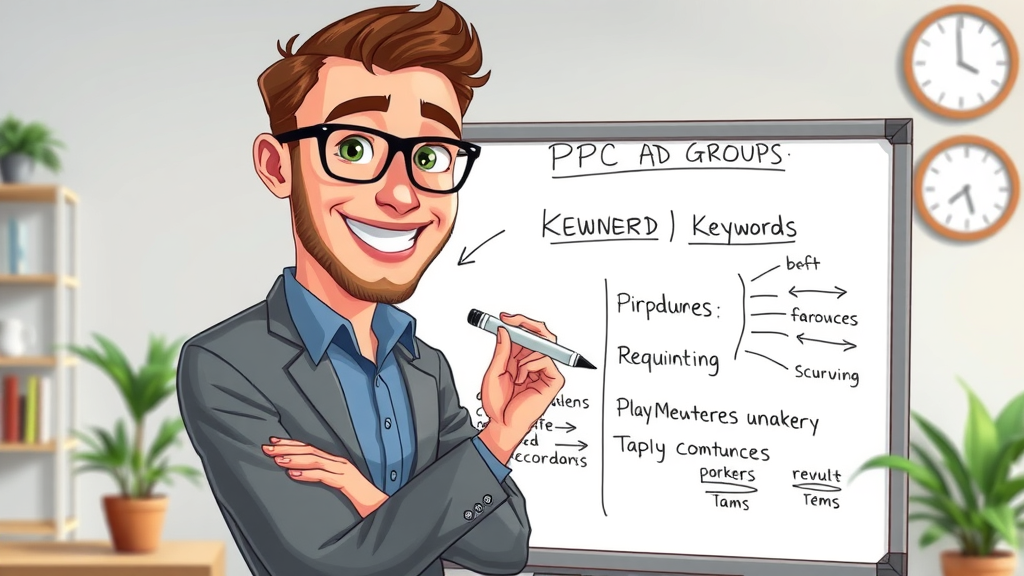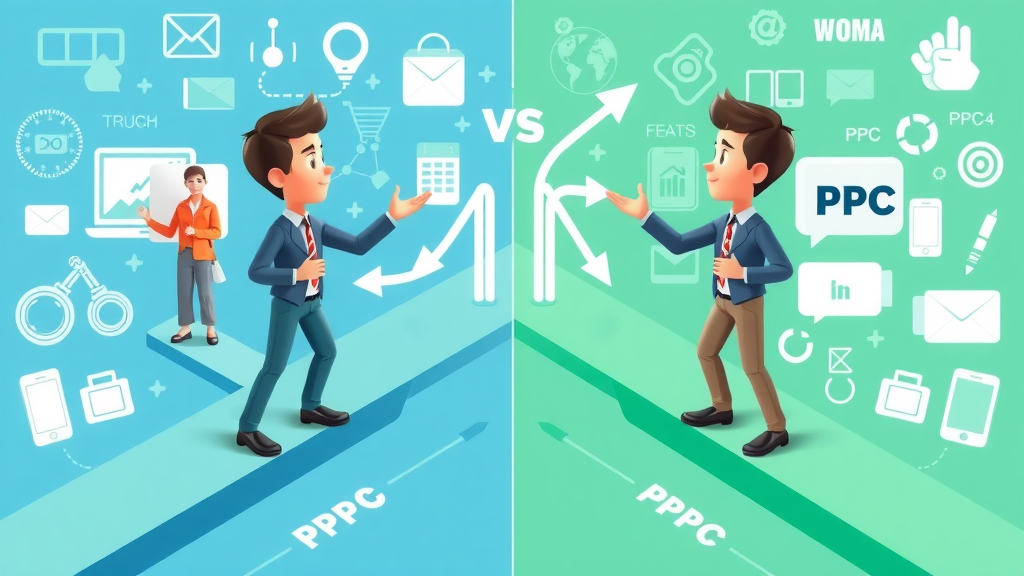Did you know that over 70% of businesses waste up to a quarter of their PPC budget due to poor management? If you're frustrated with lackluster results from your pay-per-click ads, you're not alone. With fierce competition and rapidly evolving platforms like Google Ads and Facebook Ads, navigating the world of PPC advertising can seem overwhelming. This comprehensive guide will not only explain why your ppc campaigns may be underperforming, but will also equip you with actionable solutions and modern best practices to turnaround your results. Whether you're new to pay-per-click or looking to refine your ppc ad strategy, we've gathered expert insights and real-world transformations to put you on a path to success.
- Why most pay-per-click campaigns fail and how to fix them
- Step-by-step PPC ad setup and optimization secrets
- The critical role of quality score, keyword research, and landing pages
- Modern PPC trends and campaign best practices
- Real-world case studies demonstrating successful PPC transformations

Why Most Pay-Per-Click Campaigns Fail (And How You Can Fix Yours)
"According to industry research, over 70% of businesses waste up to 25% of their PPC budget due to poor strategy and mismanagement."
Many businesses dive into pay-per-click advertising expecting instant returns, only to be disappointed by spiraling costs, low conversions, and minimal ROI. The root of these issues often lies in common missteps—lack of keyword research, poorly structured ad groups, irrelevant landing pages, and unmonitored negative keywords. These collective errors not only drain your budget but can also hurt your ad rank and relevance in search engine results.
For example, neglecting to segment ad groups or ignoring quality score insights can severely diminish the effectiveness of even the most creative ppc ads. A misaligned campaign structure leads to wasted impressions, irrelevant clicks, and higher cost per click (CPC). But the good news is that with a data-driven approach and regular campaign audits, businesses can rapidly turn their ppc campaign performance around. Understanding the pitfalls—and more importantly, how to address them—empowers advertisers to recapture wasted spend, enhance ad relevance, and maximize returns from every advertising dollar.
Understanding the Core Challenges of Pay-Per-Click
- Ineffective keyword research: Targeting the wrong keywords results in irrelevant triggers and wasted budget.
- Low quality score: Poor ad relevance, weak landing pages, or bad user experience drive down your quality score and ad rank.
- Poorly optimized landing page: Sending PPC visitors to a generic or slow-loading landing page reduces conversions and increases bounce rates.
- Misaligned ad groups: Mixing too many keywords or products in one ad group dilutes ad messaging and undermines ad relevance.
- Overlooking negative keywords: Failing to add negative keywords lets irrelevant queries trigger your ads, driving up costs unnecessarily.
Addressing these core challenges begins by viewing your ppc campaigns as a whole—not just individual ads. Each element, from the keyword list to the landing page, must support and reinforce your overall online advertising goals. By routinely reviewing ad structure and incorporating feedback from search engine metrics, you can stay ahead of common PPC pitfalls and set the stage for long-term advertising model success.

Essential Components of a Successful Pay-Per-Click Strategy
"A data-driven PPC strategy is the foundation of long-term online advertising success."
Building effective ppc advertising demands more than simply launching ads—it requires a thoughtful approach that blends robust keyword research, clear ad structure, compelling ad copy, and seamless alignment with optimized landing pages. These elements collectively raise your ad rank, attract higher-quality leads, and deliver consistent results.
At the heart of any winning ppc campaign is ongoing analysis. From adjusting keyword bids based on changing market dynamics to regularly split-testing landing pages, continuous optimization ensures your ad spend delivers maximum ROI. Additionally, segmenting ad groups based on user intent and product/service relevancy is critical. This not only supports higher click-through rates but also narrows your audience to those more likely to convert—an essential principle for every successful PPC advertiser.
PPC Ad Structure: Setting Up for Success with Ad Groups and Keywords

Creating tightly themed ad groups is fundamental for optimal ppc ad performance. Each ad group should focus on a specific set of related keywords, ensuring your ad copy is highly relevant and targeted. This structure not only improves your quality score but also increases engagement rates and lowers your average cost per click.
Successful ad groups are built around intent-driven keyword clusters—for example, instead of cramming dozens of keywords into a single group, use separate ad groups for “buy running shoes,” “men’s running sneakers,” and “discount running shoes.” This granular approach makes it easier to tailor your ppc ads’ text, monitor individual performance, and quickly pause or scale up according to real-time data from your Google Ads dashboard.
The Role of Quality Score in Pay-Per-Click Performance
Quality score is a pivotal metric within the Google Ads ecosystem, directly impacting your ad rank, cost per click, and overall eligibility to appear in top search engine results. It is calculated based on three primary components: expected click-through rate, ad relevance, and landing page experience. The higher your quality score, the less you’ll pay for each click—while also enjoying more favorable ad placements.
Improving your quality score is achievable by regularly refining keyword targeting, writing compelling ad copy, and directing traffic to fast-loading, relevant landing pages. Businesses that align their ad messaging closely with user intent and landing page content consistently see improved performance across all major ppc platforms—including Google Ads, Facebook Ads, and emerging digital networks. Monitoring quality score isn’t a one-time task; it’s an ongoing process that should influence every aspect of your PPC advertising strategy.
Optimizing Landing Pages for Pay-Per-Click Conversions

Your landing page is where the conversion magic happens. No matter how compelling your ppc ad, a slow or irrelevant landing page can torpedo your campaign’s effectiveness. A highly optimized landing page should offer instant clarity and match the user’s original search intent—whether that’s making a purchase, signing up for a newsletter, or requesting more information about your product or service.
Key elements of a high-performing landing page include a clear headline, visually engaging images, a concise value proposition, and a strong, actionable CTA (call to action). Fast load times and mobile responsiveness are non-negotiable, as they not only impact user experience but also factor into your quality score. Test variations of your landing pages using A/B testing to identify which layout, copy, and images yield the highest conversion rates. The best landing pages are always evolving based on real-time data and user feedback.
Utilizing Display Ads and Search Ads in Pay-Per-Click
Search ads and display ads serve different strategic goals in pay-per-click campaigns. Search ads appear on search engine results pages when users enter relevant queries; their high intent makes them powerful for direct conversions. In contrast, display ads are shown across a vast network of partner sites and apps, ideal for building brand awareness and retargeting past visitors.
Effective PPC advertising leverages both formats in tandem. Start with tightly focused search ads to capture users intent on immediate action, then expand your reach using display ads to maintain top-of-mind presence and re-engage those who didn’t convert on their first visit. Blending both approaches not only boosts your total impressions but also enhances brand credibility and long-term ROI.
Mastering Pay-Per-Click Keyword Research for Maximum ROI
Keyword research is the engine that drives every profitable pay-per-click campaign. Building your keyword list begins with a deep understanding of your audience—what terms are they searching for, what questions do they ask, and how do their needs change during the buyer journey? Effective keyword research tools reveal not only popular search terms but also long-tail opportunities, negative keyword exclusions, and fresh content angles to keep you ahead in the competitive ppc ads marketplace.
The secret to maximum ROI lies in targeting highly relevant, intent-driven keywords while continually refining your list based on live performance data. Avoid the mistake of chasing only high-volume, generic terms which can drain your budget; prioritize quality traffic over quantity by prioritizing phrases directly linked to your product or service. Remember, your keyword strategy should always evolve as new challenges and opportunities emerge through ongoing campaign data analysis.
How to Build a High-Converting Keyword List for PPC Ad Success

The backbone of your PPC ad performance is a precisely constructed keyword list. Start by brainstorming a broad set of seed keywords related to your business and product offerings—think like your ideal customer. Use Google Ads Keyword Planner or other professional keyword research tools to unearth related terms, question-based phrases, and high-converting long-tail queries. Analyze your competition to discover lucrative gaps in their ppc ad strategy.
Don’t underestimate the importance of regular keyword expansion and pruning. Add fresh, high-intent keywords as your campaign matures and eliminate underperformers. For each ad group, ensure the selected keywords tightly align with the group’s theme and intended landing page. Track search terms generating actual conversions and use this insight for continuous optimization. A well-managed keyword list helps you outbid competitors for the most valuable placements—without unnecessary spending.
Negative Keywords: The Secret Weapon for Pay-Per-Click Efficiency
Negative keywords are an often-overlooked but powerful aspect of every successful ppc campaign. They prevent your ads from displaying for irrelevant or low-intent search queries, saving your budget for users who are genuinely interested in your offerings. For example, if you sell premium men’s shoes, adding “free,” “DIY,” or unrelated product names like “boots” as negative keywords ensures your ads are shown only to those likely to convert.
Review your search terms report regularly to spot irrelevant clicks and update your negative keyword list accordingly. This process not only boosts your campaign’s click-through and conversion rates but also increases your quality score by enhancing ad relevance. Efficient negative keyword management is the secret weapon that separates high-ROI ppc advertisers from the rest.
| Keyword Type | Example | Effect on PPC Campaigns |
|---|---|---|
| Broad Match | shoes | High reach, low relevancy |
| Phrase Match | "red shoes" | Moderate reach, high relevancy |
| Exact Match | [red shoes men] | Low reach, highest relevancy |
Launching Your Pay-Per-Click Campaign: Best Practices and Common Mistakes

Properly launching a pay-per-click campaign sets the tone for your future results. Many advertisers mistakenly rush through campaign setup, only to pay the price in wasted ad spend and missed opportunities. The most effective PPC campaigns start with a clear objective, well-structured ad groups, and pre-tested landing pages.
Among the most common ppc campaign errors are neglecting to test your landing pages, failing to segment your audiences, and adopting a “set and forget” mentality. Equally problematic is ignoring the deeper insights offered by your quality score metrics. To set yourself apart from less disciplined advertisers, follow a methodical, data-driven launch protocol and consistently learn from your performance data.
Step-by-Step Guide to Setting Up a Pay-Per-Click Ad on Google Ads
"Success in pay-per-click advertising hinges on continuous optimization and data analysis."
Setting up your first PPC ad on Google Ads is a straightforward process—but doing it right makes all the difference. Begin by defining your campaign objective: sales, leads, website traffic, or brand awareness. Next, research and select a focused keyword list, organizing them into tightly themed ad groups.
Write attention-grabbing ad copy that clearly highlights your unique value proposition and matches the user’s search. Select or design an optimized landing page, ensuring quick load times and strong calls to action. Set your maximum cost per click according to your budget and conversion goals. Finally, activate your campaign and closely monitor your analytics dashboard for initial results, daily spend, and opportunities for immediate refinement. A successful ppc campaign is never “one and done”—evaluate and iterate often for the best outcomes.
Avoiding the Most Costly Errors in Your Pay-Per-Click Campaign
- Not segmenting ad groups: Mixing unrelated keywords leads to vague, ineffective ad messaging.
- Ignoring quality score insights: Failing to act on this vital metric results in higher costs and poor ad rank.
- Failing to test landing pages: Without testing, you miss critical clues to unlocking higher conversions.
- Setting and forgetting campaigns: Lack of ongoing optimization is a sure path to wasted spend and stagnation.
Prevent these errors by establishing a checklist of campaign setup and optimization best practices. Schedule regular reviews of ad performance, and never underestimate the power of testing new ad copy or landing page formats. A proactive stance ensures you maximize every dollar invested in PPC advertising—and continually outpace your competitors in the search engine results page.
How to Analyze and Optimize Pay-Per-Click Performance
Continuous optimization is the cornerstone of pay-per-click success. After your campaign is live, the true work begins: tracking key metrics, running experiments, and acting swiftly on new insights. Modern PPC advertisers rely on advanced analytics dashboards to monitor performance and spot undercurrents in user behavior, helping them outmaneuver rivals on both search ads and display ads platforms.
The most successful campaigns are never static. Regular analysis enables you to pause low-performing ads or keywords, shift budget into emerging opportunities, and steadily inch your ROI higher through evidence-based tweaks. If there’s one universal truth in online advertising, it’s this: the fastest learners and most responsive optimizers always win.
Key Metrics: What to Track for Effective Pay-Per-Click Optimization

- Click-Through Rate (CTR): Measures how compelling your ad is to searchers.
- Conversion Rate: Indicates what percentage of visitors from your ads convert into leads/sales.
- Cost Per Click (CPC): The average amount paid for each click—keep this in line with your budgeted ROI.
- Return on Ad Spend (ROAS): Calculates actual revenue versus ad spend and is critical for scaling efficiently.
- Quality Score: Impacts ad rank and cost; must be monitored and improved regularly.
Tracking these metrics gives you a real-time view of campaign performance and pinpoints areas for immediate adjustment. Don’t overlook deeper metrics like average position, impression share, and keyword-level performance—these can reveal hidden optimization opportunities and enable smarter, data-driven decision-making.
A/B Testing Pay-Per-Click Ads and Landing Pages for Continuous Improvement
Ongoing A/B testing is essential for advancing your ppc ad results. By systematically testing ad headlines, descriptions, and display URLs, you can identify which messages resonate best with your target audience. Similarly, experimenting with landing page layouts, color schemes, call-to-action buttons, and trust signals (such as testimonials or guarantees) can yield dramatic improvements in conversion rates over time.
Successful PPC advertisers run multiple tests simultaneously, pausing the underperformers and scaling up the winners. Document each test, analyze the data, and use your findings to build a playbook of best practices for your business. The best results come from a culture of experimentation and rapid learning—a hallmark of every high-performing pay-per-click and ppc ads strategy.
| Metric | Target Goal | Current Value |
|---|---|---|
| Click-Through Rate | >4.5% | 3.8% |
| Conversion Rate | >3% | 2.1% |
| Average CPC | <$1.00 | $1.15 |
| Quality Score | 7+ | 6 |
Pay-Per-Click vs. PPC Advertising: Key Differences and Modern Best Practices

Though often used interchangeably, “pay-per-click” and “PPC advertising” may refer to nuanced approaches within the digital advertising landscape. Pay-per-click specifically describes the advertising model where the advertiser pays a fee each time an ad is clicked—common across Google Ads, Facebook Ads, and other ppc platforms. In contrast, PPC advertising encompasses the broader methodologies for implementing, optimizing, and scaling these campaigns across various engines, networks, and targeting strategies.
To thrive in today’s evolving PPC environment, modern advertisers are leveraging new tools and technologies to gain competitive advantage. The convergence of AI-driven optimization, dynamic landing pages, search ad and display ad integrations, and cross-channel data sharing is defining the latest wave of PPC innovation. Stay current by regularly reviewing emerging trends, updating your approach, and never hesitating to experiment with new campaign formats or targeting models.
- Leveraging AI for PPC optimization
- Integration with search ads and display ads
- Personalization with dynamic landing pages
Expert Answers: People Also Ask about Pay-Per-Click
Is PPC better than SEO?
PPC and SEO serve different online advertising goals. PPC ads deliver immediate visibility and results—you can be on the top of the search engine results page within minutes of launching a campaign. SEO is a long-term investment with compounding value; while it takes longer, it builds trust and sustained traffic over time. The best strategy is often a hybrid: use PPC for rapid testing, lead generation, or product launches, while building SEO for stable, cost-effective organic rankings.
What is an example of a PPC?
A classic example of pay-per-click (PPC) is running a Google Ad that appears every time a user searches for “best running shoes.” When someone clicks your ad to visit your landing page, you, the advertiser, pay Google a small fee for that visit. This advertising model is used across search engines, social media (like Facebook Ads), and even large e-commerce sites displaying text ads or shopping product listings.
How much can I get paid per click?
Advertisers pay per click, not get paid, in the traditional PPC model. However, if you participate as a publisher (displaying others’ ads on your site via Google AdSense), you may earn a few cents to several dollars per click depending on the niche, competition, and user intent. For most businesses running PPC campaigns, expect to pay between $0.50 and $5.00 per click—though highly competitive industries can see significantly higher costs.
Is pay-per-click illegal?
No, pay-per-click is a legal and widely accepted form of online advertising used by businesses worldwide. However, fraudulent click activity—such as click fraud, where competitors or malicious actors repeatedly click ads to drain your budget—is prohibited and monitored by most major ppc platforms. Running ethical, transparent PPC ads and regularly monitoring your analytics helps protect your campaigns and ensures compliance with all platform policies.
Real-World Pay-Per-Click Transformation: Success Stories and Case Studies

Case Study: From Wasted Budget to Lead Generation Powerhouse with PPC Ads
"By restructuring their pay-per-click campaign, Company X improved conversion rates by 150% and lowered cost per acquisition by 30%."
Company X, an online retailer, invested heavily in PPC ads for nine months but struggled with low conversion rates and a rising cost per click. After a thorough audit, the team overhauled their ad groups, banked on high-intent keyword research, and redesigned their landing pages for optimal speed and relevance. Results were dramatic: not only did conversion rates jump by 150%, but overall cost per acquisition dropped by nearly a third, quickly turning a losing campaign into a major growth channel. The lessons learned—rigid campaign segmentation, robust negative keyword management, and relentless A/B testing—now serve as internal gold standards for their future digital marketing efforts.

Practical Takeaways from High-Performing Pay-Per-Click Campaigns
- Focus on targeted keyword research
- Continuously optimize landing pages
- Use data-driven ad groups for better segmentation
- Monitor quality scores regularly
Adhering to these principles not only safeguards your PPC advertising budget but also puts you consistently ahead in the competitive bidding landscape. The difference makers are those willing to scrutinize every metric, refine every step, and relentlessly pursue incremental gains with every campaign iteration.
Ready to Fix Your Pay-Per-Click Performance and Drive Results?

If you’re ready to end PPC frustration and unlock consistent results, we’re here to help. Call us at (385) 469-1869 or email at info@solu4u.com today! Our pay-per-click experts offer tailored strategies, comprehensive audits, and hands-on support to turn your advertising investment into real business growth. Don’t settle for average—partner with professionals and watch your results soar.
Conclusion
Take control of your pay-per-click campaigns by focusing on robust keyword research, precise ad group segmentation, optimized landing pages, and relentless data-driven improvement. Your next breakthrough starts with a single click.
Sources
- https://www.wordstream.com/blog/ws/2014/03/17/common-ppc-mistakes
- https://searchengineland.com/the-big-list-of-ppc-tools-239369
- https://support.google.com/google-ads/answer/6167122
- https://semrush.com/blog/ppc-best-practices/
- https://www.hubspot.com/pay-per-click
- https://ahrefs.com/blog/negative-keywords/
- https://www.wordstream.com/ppc-quality-score
To enhance your understanding of pay-per-click (PPC) advertising and avoid common pitfalls, consider exploring the following resources:
-
“7 Common PPC Ad Mistakes to Avoid” : This article outlines frequent errors in PPC campaigns, such as neglecting keyword research and failing to define a specific audience, providing actionable solutions to improve your ad performance. ( notothequo.com )
-
“Common PPC Campaign Mistakes (And How To Avoid Them)” : This resource delves into critical missteps like not running split tests and overlooking geo-targeting, offering strategies to refine your PPC approach and maximize return on investment. ( ignitevisibility.com )
By reviewing these articles, you’ll gain valuable insights into optimizing your PPC campaigns, ensuring efficient use of your advertising budget, and achieving better results.
 Add Row
Add Row  Add
Add 




Write A Comment